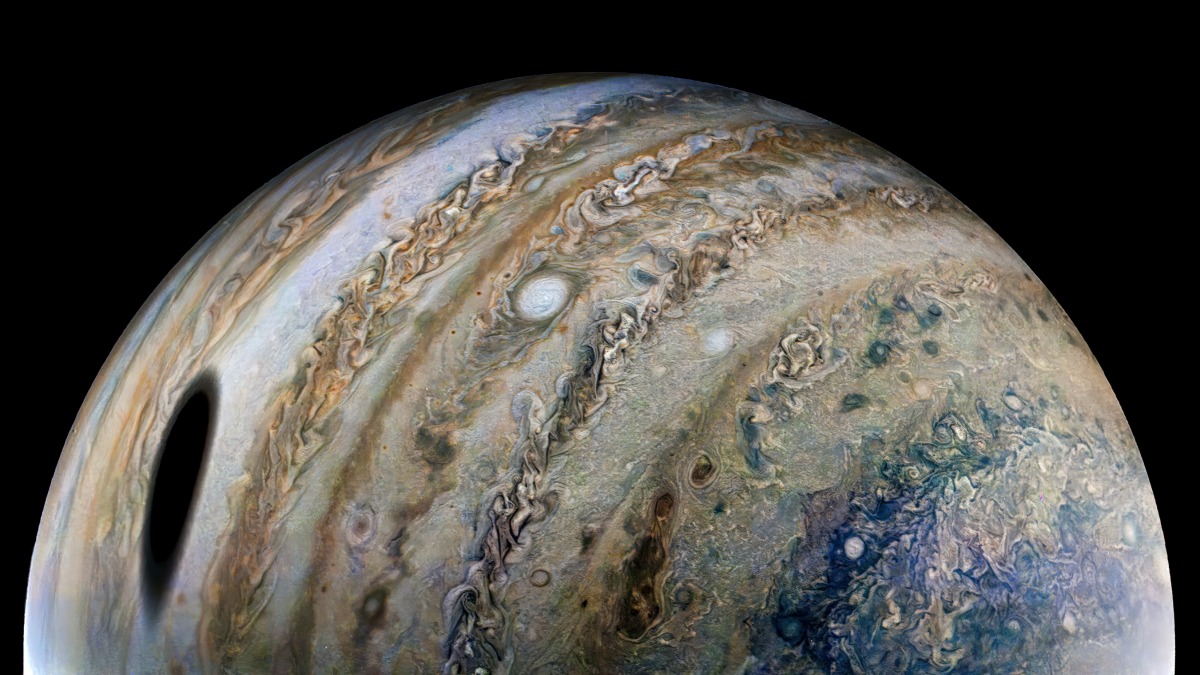Shadow of Jupiter's largest moon looms in magnificent new Juno photo

Giant Jupiter and the shadow of its biggest moon, Ganymede, dominate the view in this latest image from the system based on a NASA spacecraft's data.
NASA's Juno mission whizzed close by the radiation-spewing planet for the 40th time on Feb. 25, with the resulting raw images of the encounter beamed home to Earth. There, citizen scientist Thomas Thomopoulos created this stunning view based on what was seen by the JunoCam instrument.
Juno was flying roughly 44,000 miles (71,000 kilometers) above Jupiter's cloud tops during the encounter, which is roughly 15 times closer than Ganymede's orbital distance of 666,000 miles (1.1 million kilometers), NASA stated.
Related: Juno snaps stunning photos of crescent Jupiter and Ganymede
If an observer could brave the radiation to float within the oval seen in the picture, NASA added, that person would experience a total eclipse of the sun. "Total eclipses are more common on Jupiter than Earth," the agency said, noting the planet hosts four large moons (Ganymede, Io, Europa and Callisto) that orbit closer to the plane of Jupiter than our own, singular moon.
JunoCam, the agency said, "captured this image from very close to Jupiter, making Ganymede's shadow appear especially large."
The Juno spacecraft is on a long-term mission to understand the weather and the dynamics of Jupiter, the largest planet of our solar system. Studying this planet from up close allows scientists also to get a sense of how large exoplanets may behave in other solar systems.
Get the Space.com Newsletter
Breaking space news, the latest updates on rocket launches, skywatching events and more!
Juno remains in good health amid an extended mission, but will have a limited lifespan due to the amount of radiation it is facing, NASA has warned. But space scientists have big plans for the icy moons of Jupiter in the 2030s, including visits from NASA's Europa Clipper and the European Space Agency's Jupiter Icy Moons Explorer.
Follow Elizabeth Howell on Twitter @howellspace. Follow us on Twitter @Spacedotcom and on Facebook.
Join our Space Forums to keep talking space on the latest missions, night sky and more! And if you have a news tip, correction or comment, let us know at: community@space.com.

Elizabeth Howell (she/her), Ph.D., was a staff writer in the spaceflight channel between 2022 and 2024 specializing in Canadian space news. She was contributing writer for Space.com for 10 years from 2012 to 2024. Elizabeth's reporting includes multiple exclusives with the White House, leading world coverage about a lost-and-found space tomato on the International Space Station, witnessing five human spaceflight launches on two continents, flying parabolic, working inside a spacesuit, and participating in a simulated Mars mission. Her latest book, "Why Am I Taller?" (ECW Press, 2022) is co-written with astronaut Dave Williams.









